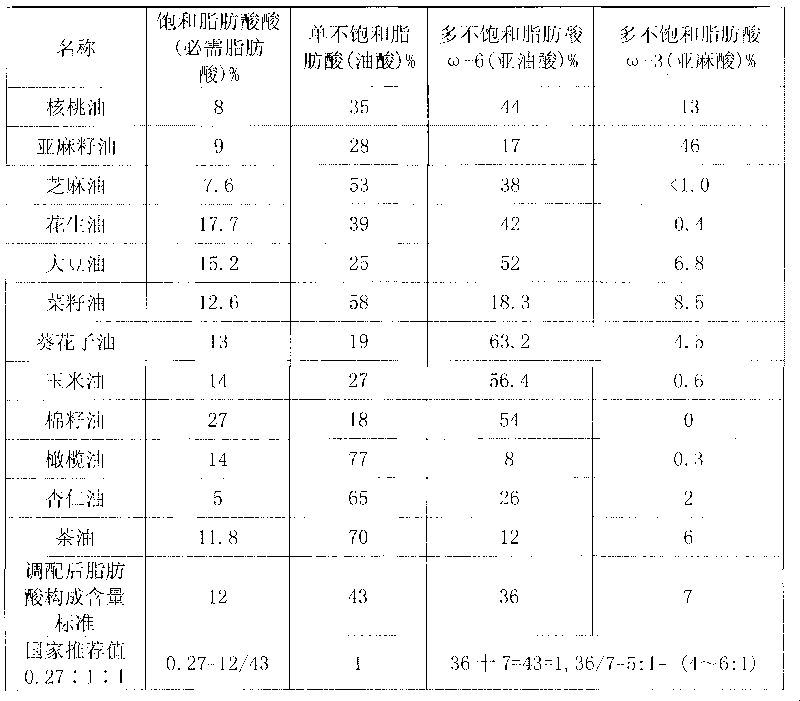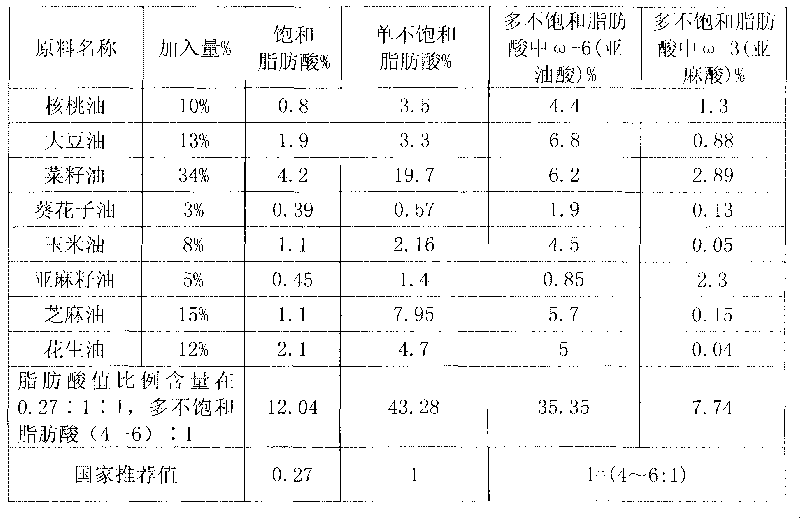Blend oil with proportional fatty acid prepared by walnut oil and other plant oils
A technology of unsaturated fatty acid and vegetable oil, applied in the field of edible blending oil, can solve the problems of high price and cannot be used as oil, achieve the effect of preventing coronary heart disease, reducing the probability of thrombosis, and overcoming the high price
- Summary
- Abstract
- Description
- Claims
- Application Information
AI Technical Summary
Problems solved by technology
Method used
Image
Examples
Embodiment 1
[0014] The blend oil that the present embodiment provides is formulated with the balanced fatty acid ratio by walnut oil and other vegetable oils is by weight 5% walnut oil, 5% linseed oil, 20% sesame oil, 4% peanut oil, 33% Canola oil, 13% soybean oil and 20% corn oil. The percentage content of various edible oil fatty acids forming fat in the blended oil in the total fatty acids is: 11%-13% of saturated fatty acids; 40%-47% of monounsaturated fatty acids; ω-6 (linoleic acid) in polyunsaturated fatty acids acid) 33%-38%; polyunsaturated fatty acid omega-3 (linolenic acid) 7%-9%; total polyunsaturated fatty acid 40%-47%. See Table 2 for the content of saturated fatty acids, monounsaturated fatty acids and polyunsaturated fatty acids in the above-mentioned various raw materials and prepared edible blending oil:
[0015] Table II
[0016]
Embodiment 2
[0018] The blend oil that the present embodiment provides is formulated with the balanced fatty acid ratio by walnut oil and other vegetable oils is by weight 10% walnut oil, 13% soybean oil, 34% rapeseed oil, 3% sunflower oil, 8% Corn oil, 5% linseed oil, 15% sesame oil and 12% peanut oil. The percentage by weight of various edible oil fatty acids that make up the fat in the blended oil is: 11%-13% of saturated fatty acids; 40%-47% of monounsaturated fatty acids; Oleic acid) 33%-38%; omega-3 (linolenic acid) in polyunsaturated fatty acids 7%-9%; total polyunsaturated fatty acids 40%-47%. See Table 3 for the contents of saturated fatty acids, monounsaturated fatty acids and polyunsaturated fatty acids in the above-mentioned various raw materials and prepared edible blending oils:
[0019] Table three
[0020]
Embodiment 3
[0022] The blend oil that present embodiment provides is formulated with the balanced fatty acid ratio by walnut oil and other vegetable oils is by weight the walnut oil of 15%, the linseed oil of 3%, the soybean oil of 10%, the rapeseed oil of 32%, 17% sesame oil, 10% corn oil and 13% peanut oil. The percentage by weight of various edible oil fatty acids that make up the fat in the blended oil is: 11%-13% of saturated fatty acids; 40%-47% of monounsaturated fatty acids; Oleic acid) 33%-38%; omega-3 (linolenic acid) in polyunsaturated fatty acids 7%-9%; total polyunsaturated fatty acids 40%-47%. See Table 4 for the contents of saturated fatty acids, monounsaturated fatty acids and polyunsaturated fatty acids in the above-mentioned various raw materials and prepared edible blending oils:
[0023] Table four
[0024]
PUM
 Login to View More
Login to View More Abstract
Description
Claims
Application Information
 Login to View More
Login to View More - R&D
- Intellectual Property
- Life Sciences
- Materials
- Tech Scout
- Unparalleled Data Quality
- Higher Quality Content
- 60% Fewer Hallucinations
Browse by: Latest US Patents, China's latest patents, Technical Efficacy Thesaurus, Application Domain, Technology Topic, Popular Technical Reports.
© 2025 PatSnap. All rights reserved.Legal|Privacy policy|Modern Slavery Act Transparency Statement|Sitemap|About US| Contact US: help@patsnap.com



